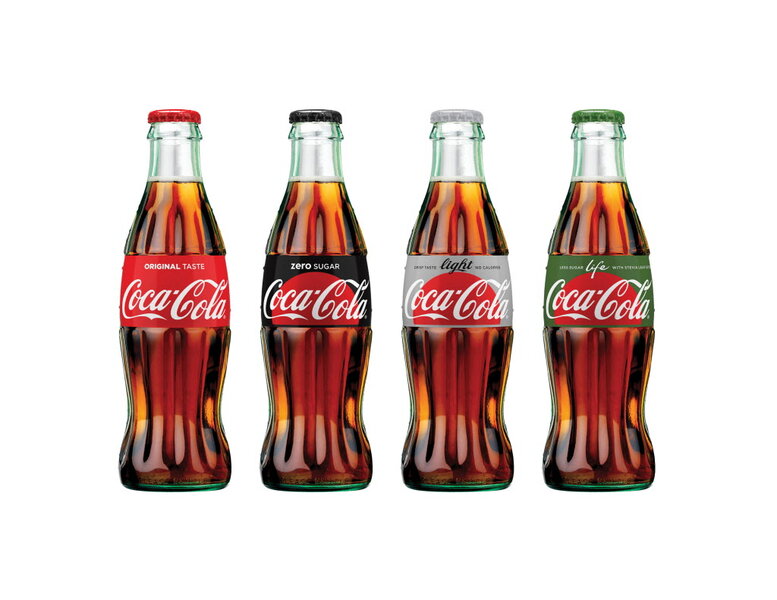How much longer will Coca-Cola and Pepsi be 'soda' companies?
Loading...
Coca-Cola is getting a makeover.
The soda company announced Tuesday that it will be unifying its products under a “One Brand” marketing strategy in order to create a cohesive look across global markets. It’s also joining others in the soda business in recognizing the need to adapt to consumers’ changing tastes.
As part of the design change, Coca-Cola products will feature a red disk and graphics that clearly identify each individual Coke option while integrating them into a more cohesive, single brand. Under the new look, options like Diet Coke, Coca-Cola Zero, and Coca-Cola Classic look less like individual products and more like pieces of a set.
The “One Brand” strategy is scheduled to roll out first in Mexico, and will land in other markets throughout 2016 and into 2017.
Coca-Cola said that the design change is part of a move to more clearly signal to consumers which Coke products will fit their lifestyles. Although soda and soft drinks still account for 73 percent of Coca-Cola’s core market, that number is declining as consumers move away from sugary beverages.
And it's not the only beverage company faced with adapting to a changing clientele. On Monday, PepsiCo CEO Indra Nooyi said that soda now accounts for less than 25 percent of the company’s global sales, with just 12 percent coming from sales of Pepsi soda. Instead, PepsiCo relies more heavily on “everyday nutrition” items, like bottled water and its snack foods division, even prompting some debate on Twitter over whether the company should change its name altogether.
For both Coke and Pepsi, a shift away from their soda-centric identities is crucial to their survival. In 1998, the average American drank 56 gallons of soda annually. By 2014, it was 42 gallons, according to Beverage Digest. Soda sales have declined each of the last 11 years.
With One Brand, Coca-Cola is navigating the shift while trying to preserve Coke's status as a household name, Amy Bentley, a professor of Food Studies at New York University, tells the Monitor in a phone interview.
“They’re not changing what’s iconic, the red brand and lettering, and that’s one of the most hugely recognized brand images around,” she explains. “[One Brand is] tweaking what’s already a very successful brand icon to keep consumer interest. Soda consumption is going down, [and] both Coke and Pepsi are expanding their product lines to compensate with that.”
In a press release, James Sommerville, Coca-Cola’s Vice President of Global Design, said the new brand strategy “utilizes a historical brand icon to present the range of Coca-Cola products available today in a contemporary and simple way.”
Soda's decline stems in large part from increased public awareness about obesity, in which experts contend sugary drinks have played a large part. In response, Coke and Pepsi have made concessions, such as introducing smaller beverage containers as an alternative to full-size soda bottles and no longer marketing soda directly to children.
But some regulators and public health advocates argue those reforms aren't enough. Kathleen Keller, an assistant professor in the Department of Nutritional Sciences and Food Science at Penn State University, tells the Monitor in a phone interview that too many food companies are instead using their ad dollars to merely market different sugary options to children.
“If you ask companies…the data that they cite for that is saying that they’re not advertising soda to kids as much, but what you see is that they’re not advertising soda, but they are advertising sugar-sweetened beverages in the form of teas or juice drinks. They are essentially just shifting the advertising dollars to other products in their portfolio,”she says.
Dr. Keller explains that the way children respond to food brands they recognize can have a tremendous influence on their eating habits.
“Kids don’t know the purpose of advertising is to sell them a product,” she says. “They think it’s fun, it’s supposed to be entertaining and rewarding… but they don’t necessarily know what the purpose is behind it.”
Advocates say that public measures, like soda taxes to discourage consumption, are more effective. The idea has faced considerable opposition in the United States. Berkeley, California is the only city in the US to have successfully voted in a soda tax. But Mexico’s soda tax has coincided with 12-percent decline in soda sales since it was implemented in 2014. In March, Britain announced that it will also introduce a soda tax to curb childhood obesity. The British government has said that one in five English children is obese by the time they leave primary school.









